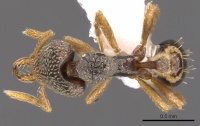Strumigenys nummula
| Strumigenys nummula | |
|---|---|

| |
| Scientific classification | |
| Kingdom: | Animalia |
| Phylum: | Arthropoda |
| Class: | Insecta |
| Order: | Hymenoptera |
| Family: | Formicidae |
| Subfamily: | Myrmicinae |
| Tribe: | Attini |
| Genus: | Strumigenys |
| Species: | S. nummula |
| Binomial name | |
| Strumigenys nummula Bolton, 2000 | |
Known from both litter and fogging samples in rainforest.
Identification
Bolton (2000) - A member of the emdeni complex in the Strumigenys horvathi-group. This is the only species of the emdeni-complex to possess a pronotal humeral hair and to have a series of 3 pairs of stiffly erect hairs on the mesonotal dorsum.
Keys including this Species
Distribution
Latitudinal Distribution Pattern
Latitudinal Range: -17.11667061° to -17.5°.
| North Temperate |
North Subtropical |
Tropical | South Subtropical |
South Temperate |
- Source: AntMaps
Distribution based on Regional Taxon Lists
Australasian Region: Australia (type locality).
Distribution based on AntMaps
Distribution based on AntWeb specimens
Check data from AntWeb
Countries Occupied
| Number of countries occupied by this species based on AntWiki Regional Taxon Lists. In general, fewer countries occupied indicates a narrower range, while more countries indicates a more widespread species. |

|
Estimated Abundance
| Relative abundance based on number of AntMaps records per species (this species within the purple bar). Fewer records (to the left) indicates a less abundant/encountered species while more records (to the right) indicates more abundant/encountered species. |

|
Biology
Castes
Nomenclature
The following information is derived from Barry Bolton's Online Catalogue of the Ants of the World.
- nummula. Strumigenys nummula Bolton, 2000: 976, fig. 531 (w.) AUSTRALIA.
Unless otherwise noted the text for the remainder of this section is reported from the publication that includes the original description.
Description
Worker
Holotype. TL 2.5, HL 0.68, HW 0.53, CI 78, ML 0.23, MI 34, SL 0.31, SI 58, PW 0.29, AL 0.68. Characters of emdeni-complex. Inner margin of mandible with a narrow translucent cuticular crest. Outer curvature of eyes just visible in full-face view, upper scrobe margins approximately straight. With head in profile the scrobe strongly developed behind the level of the eye, deep, clearly defined and with sharp dorsal, ventral and posterior margins. Cephalic dorsum densely clothed with very conspicuous spoon-shaped to scale-like ground-pilosity but this pilosity not reproduced on promesonotal dorsum where it consists of scattered small spatulate hairs, the overall appearance of the ground-pilosity is much less dense and much weaker than on the cephalic dorsum. One or two very short erect hairs present on occipital margin at each side, near apices of occipital lobes. Pronotal dorsum without standing hairs but humerus with a short straight hair that is directed laterally. Mesonotum with 3 pairs of short erect hairs, the posterior pair the longest. First gastral tergite with numerous erect stiff hairs, some of them slightly thickened or flattened apically, or weakly remiform. Dorsum of head and alitrunk uniformly reticulate-punctate. Side of alitrunk with katepisternum smooth, and a smooth patch present that covers the upper metapleuron and lower side of the propodeum. Disc of postpetiole smooth and shining.
Paratypes. TL 2.4-2.6, HL 0.70-0.71, HW 0.56-0.58, CI 80-82, ML 0.24, MI 33-34, SL 0.32-0.33, SI 57, PW 0.31-0.32, AL 0.68 (2 measured).
Type Material
Holotype worker, Australia: North Queensland, Lamb Range, 19 km. SE Mareeba, 3.xii.1988, 1200 m, pyrethrum/logs & trees (Monteith & Thompson) (Australian National Insect Collection). Paratypes. 1 worker, Australia: North Queensland, Mt Fisher, 7 km. SW Millaa Millaa (Whiteing Ridge), 5.v.1983, QM Berlesate No. 585, 17. 34S, 145.34E, 1200 m, rainforest, sieved litter (G. B. Monteith & D. K. Yeates); 1 worker, North East Queensland, Upper Boulder Creek via Tully, 27.x.1983, QM Berlesate No. 618, 17.50S, 145.54E, 900 m, rainforest, sieved litter (Monteith, Yeates & Thompson) (ANIC, The Natural History Museum).
- Holotype, worker, 19km SE Mareeba, Lamb Range, Queensland, Australia, Monteith,G.B. & Thompson,G., ANIC32-017780, Australian National Insect Collection.
- Paratype, 1 worker, Mt. Fisher, 7km SW Millaa Millaa (Whiteing Ridge), Queensland, Australia, Australian National Insect Collection or The Natural History Museum.
- Paratype, 1 worker, Upper Boulder Creek via Tully, Queensland, Australia, Australian National Insect Collection or The Natural History Museum.
References
- Bolton, B. 2000. The ant tribe Dacetini. Memoirs of the American Entomological Institute. 65:1-1028. (page 976, fig. 531 worker described)

